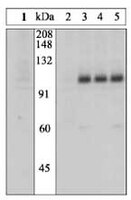407707 Sigma-AldrichPhosphoDetect™ Anti-Insulin Receptor (pTyr1162/1163) Rabbit pAb
This PhosphoDetect™ Anti-Insulin Receptor (pTyr1162/1163) Rabbit pAb is validated for use in ELISA, WB, ICC for the detection of Insulin Receptor (pTyr1162/1163).
More>> This PhosphoDetect™ Anti-Insulin Receptor (pTyr1162/1163) Rabbit pAb is validated for use in ELISA, WB, ICC for the detection of Insulin Receptor (pTyr1162/1163). Less<<Recommended Products
Overview
| Replacement Information |
|---|
Key Spec Table
| Species Reactivity | Host | Antibody Type |
|---|---|---|
| H | Rb | Polyclonal Antibody |
Pricing & Availability
| Catalogue Number | Availability | Packaging | Qty/Pack | Price | Quantity | |
|---|---|---|---|---|---|---|
| 407707-10T |
|
Plastic ampoule | 10 t |
|
— |
| Product Information | |
|---|---|
| Form | Liquid |
| Formulation | In Dulbecco's PBS (without Mg2+ and Ca2+), 50% glycerol, 1 mg/ml BSA, pH 7.3. |
| Preservative | ≤0.1% sodium azide |
| Quality Level | MQ100 |
| Physicochemical Information |
|---|
| Dimensions |
|---|
| Materials Information |
|---|
| Toxicological Information |
|---|
| Safety Information according to GHS |
|---|
| Safety Information |
|---|
| Product Usage Statements |
|---|
| Packaging Information |
|---|
| Transport Information |
|---|
| Supplemental Information |
|---|
| Specifications |
|---|
| Global Trade Item Number | |
|---|---|
| Catalogue Number | GTIN |
| 407707-10T | 04055977211474 |
Documentation
PhosphoDetect™ Anti-Insulin Receptor (pTyr1162/1163) Rabbit pAb MSDS
| Title |
|---|
PhosphoDetect™ Anti-Insulin Receptor (pTyr1162/1163) Rabbit pAb Certificates of Analysis
| Title | Lot Number |
|---|---|
| 407707 |
References
| Reference overview |
|---|
| Bevan, P. 2001. J. Cell Sci. 114, 1429. Ottensmeyer, F.P., et al. 2000. Biochemistry 39, 12103. Virkamaki, A., et al. 1999. J. Clin. Invest. 103, 931. Schmid, E., at al. 1998. FASEB J. 12, 863. Hari, J. and Roth, R.A. 1987. J. Biol. Chem. 262, 15341. Morgan, D.O., et al. 1986. Proc. Natl. Acad. Sci. USA 83, 328. White, M.F. and Kahn, C.R. 1986. The Enzymes 17, 247. Ebina, Y., et al. 1985. Cell 40, 747. Ganguly, S., et al. 1985. Current Topics in Cellular Regulation 27, 83. Grunberger, G., et al. 1984. Science 223, 932. |








